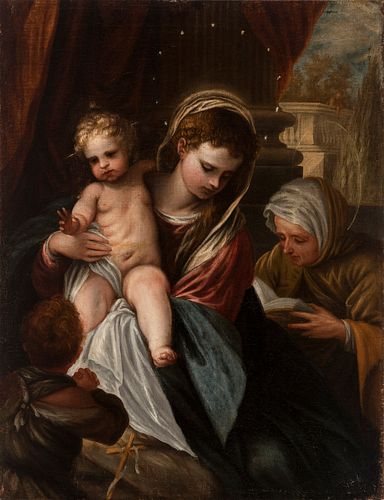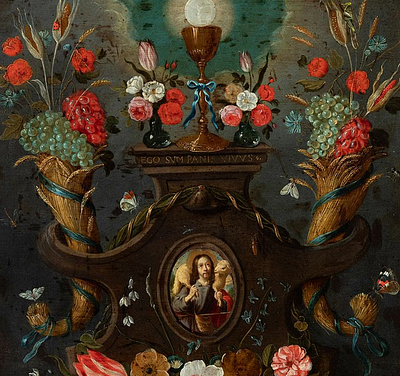ANTONIO FRÍAS Y ESCALANTE Cordoba, 1633 - Madrid, 1669). “La Virgen con el Niño, San Juanito y Santa Ana”. Oil on canvas. Relining.
Lot 42
About Seller
Setdart Auction House
Carrer Aragó 346
Barcelona
Spain
Setdart Subastas was born in 2004 and is currently the first online art auction in Spain with solidity, prestige and reliability guaranteed by our more than 60,000 users. Setdart has a young, dynamic and enterprising team ready to successfully manage the purchase and sale of art works through custom...Read more
Estimate:
EUR€9,000 - EUR€10,000
$9,473.68 - $10,526.32
Absentee vs Live bid
Two ways to bid:
- Leave a max absentee bid and the platform will bid on your behalf up to your maximum bid during the live auction.
- Bid live during the auction and your bids will be submitted real-time to the auctioneer.
Bid Increments
| Price | Bid Increment |
|---|---|
| EUR€0 | EUR€10 |
| EUR€200 | EUR€25 |
| EUR€500 | EUR€50 |
| EUR€1,000 | EUR€100 |
| EUR€3,000 | EUR€200 |
| EUR€5,000 | EUR€500 |
| EUR€10,000 | EUR€1,000 |
| EUR€20,000 | EUR€2,000 |
| EUR€50,000 | EUR€5,000 |
About Auction
By Setdart Auction House
Sep 21, 2021
Set Reminder
2021-09-21 10:00:00
2021-09-21 10:00:00
America/New_York
Bidsquare
Bidsquare : 21st September - ARAS JÁUREGUI Private Collection - Old Masters, 19th & 20th Century
https://www.bidsquare.com/auctions/setdart-auction-house/21st-september---aras-j-uregui-private-collection---old-masters-19th-20th-century-7429
Setdart Auction House sofia@setdart.com
Setdart Auction House sofia@setdart.com
- Lot Description
ANTONIO FRÍAS Y ESCALANTE Cordoba, 1633 - Madrid, 1669). “La Virgen con el Niño, San Juanito y Santa Ana”. Oil on canvas. Relining. It presents restorations and repainting. Measurements: 107 x 85 cm. The Virgin holding the Child on her lap, directs her look to the book that her mother, Saint Anne, is holding. A gesture in which the author portrays the intimacy between both women, and their complicity, showing the spectator an intimate scene close to everyday life. In a classical triangular composition, the Child is almost in the centre, with his nudity and the glow of his pearly skin standing out in particular. The scene is completed by the figure of San Juanito, with his back to the viewer, and another figure in the background, in the exterior that can be seen through the main opening, limited by the large curtain. This figure, depicted on the canvas in a sketchy, sketchy manner, seems to represent a saint, as a sort of nimbus is visible. With regard to the technique, it is worth mentioning the quality of the drawing and the softness of the forms, whose greatest example is the delicacy of the Virgin's face, and in turn the contrast between her and her elderly mother. This technical purity, together with the use of earthy colours, is very reminiscent of the work of Antonio Frías y Escalante, an example of which is the work in the Museo Nacional de Prado, known as the Holy Family. Both works have similarities, although the figures are different. However, the composition and the chromatic range coincide to a large extent. A member of what is known as the "truncated generation", Antonio Frías y Escalante was a disciple of Francisco Rizzi, with whom he worked from a very young age. The brevity of his life prevented him from developing an artistic maturity that augured great achievements, as his contemporaries expected, but from the outset his works show his admiration for Venice, especially Tintoretto and Veronese. Thus, his followers would take from him his characteristic and personal chromatic range, centred on cold colours, a very refined palette of pinks, blues, greys and mauves, which we see in part in this canvas, especially in the draperies, although here the cold tones are offset by the warmth of the golds and carmines. Also typical of Escalante is the light, delicate, almost transparent brushstroke in which the example of Titian is evident.
- Shipping Info
-
In-house shipping available. Please inquire at admin@setdart.com.
-
- Buyer's Premium



 EUR
EUR CAD
CAD AUD
AUD GBP
GBP MXN
MXN HKD
HKD CNY
CNY MYR
MYR SEK
SEK SGD
SGD CHF
CHF THB
THB

















